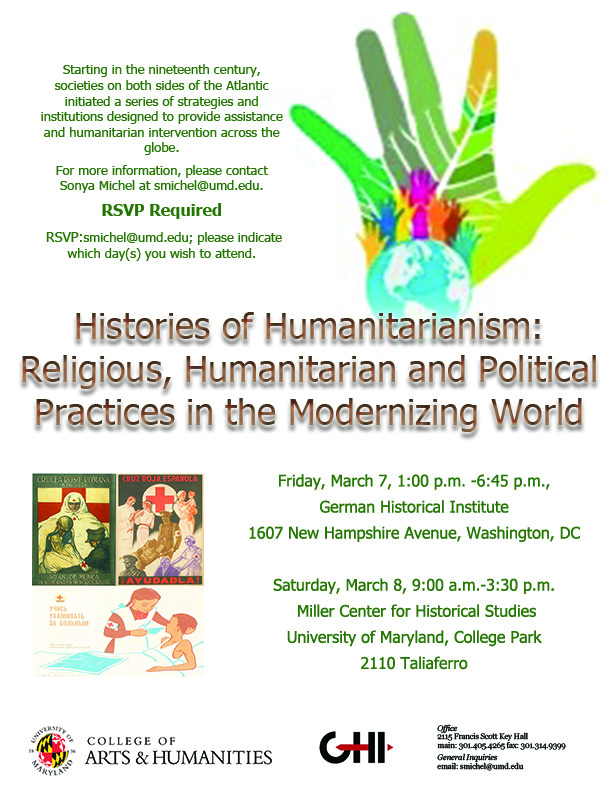Histories of Humanitarianism: Religious, Humanitarian and Political Practices in the Modernizing World

Histories of Humanitarianism: Religious, Humanitarian and Political Practices in the Modernizing World
Conveners: Sonya Michel, University of Maryland, College Park, USA’ Britta Waldschmidt-Nelson, German Historical Institute, Washington, DC
Friday, March 7, 1 -6:45 p.m., German Historical Institute,
1607 New Hampshire Avenue, Washington, DC
Saturday, March 8, 9 a.m.-3:30 p.m., Miller Center for Historical Studies,
University of Maryland, College Park, 2110 Taliaferro
Starting in the nineteenth century, societies on both sides of the Atlantic initiated a series of strategies and institutions designed to provide assistance and humanitarian intervention across the globe. Rooted in earlier colonial religious missions as well as domestic relief organizations, these practices constituted what one historian calls “global aid cultures.” Both religious and secular organizations became global players seeking to rescue, “save,” relieve and reform designated beneficiary populations beyond their own borders. As NGOs largely independent of national governments, they acted as agents of globalization processes that reached an initial highpoint at the end of the nineteenth century.
Establishing sophisticated transnational networks as well as a broad variety of supporting measures, they carried messages of “modernization” to societies in transformation and assistance in times of crisis, responding to famine and other natural disasters as well as the ravages of war. At the same time, they allowed individuals, secular as well as religious, to pursue meaningful careers; this was especially important for female philanthropists, missionaries, and relief workers whose own societies often denied them similar vocational opportunities. Working together, these historical actors instantiated a women’s internationalism at the level of people and organizations, politics and ideas.
Developments in the early twentieth century challenged earlier global aid cultures in several ways. First, in the wake of the Great War, the formation of the League of Nations – the world’s first official intergovernmental entity--transformed the context for international relief work, while the scale of the crisis produced by the war demanded a new level of humanitarian response. At the same time, the organizations themselves were becoming increasing bureaucratized and professionalized, displacing individuals who had previously been able to participate on a voluntary basis and questioning their motivation.
The context for international assistance shifted once again with yet another escalation in the scale of humanitarian disaster in the wake of World War II, the founding of the UN and its affiliated agencies, the wave of decolonization, and the spread of the Cold War. Yet, religious arguments for humanitarian practices persisted, and both religious and secular NGOs remained robust, existing alongside, sometimes cooperating, sometimes in tension expanding international organizations. As humanitarianism became ever more a global enterprise on the part of the world’s wealthy nations and a tool of their foreign policy, recipient populations began to mobilize and assert agency in claiming aid and shaping it according to their own perceptions of need.
For more information, please contact Sonya Michel at smichel@umd.edu. RSVP Required: smichel@umd.edu; please indicate which day(s) you wish to attend.

